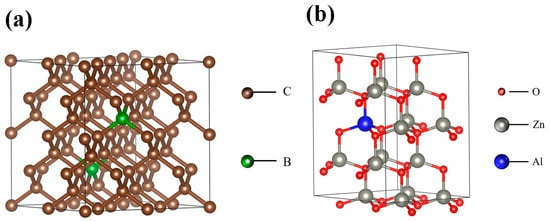Enhanced Photoluminescence and Electrical Properties of n-Al-Doped ZnO Nanorods/p-B-Doped Diamond Heterojunction
Post Date: 11 May 2022 Viewed: 767
Abstract
The hydrothermal approach has been used to fabricate a heterojunction of n-aluminum-doped ZnO nanorods/p-B-doped diamond (n-Al:ZnO NRs/p-BDD). It exhibits a significant increase in photoluminescence (PL) intensity and a blue shift of the UV emission peak when compared to the n-ZnO NRs/p-BDD heterojunction. The current voltage (I-V) characteristics exhibit excellent rectifying behavior with a high rectification ratio of 838 at 5 V. The n-Al:ZnO NRs/p-BDD heterojunction shows a minimum turn-on voltage (0.27 V) and reverse leakage current (0.077 μA). The forward current of the n-Al:ZnO NRs/p-BDD heterojunction is more than 1300 times than that of the n-ZnO NRs/p-BDD heterojunction at 5 V. The ideality factor and the barrier height of the Al-doped device were found to decrease. The electrical transport behavior and carrier injection process of the n-Al:ZnO NRs/p-BDD heterojunction were analyzed through the equilibrium energy band diagrams and semiconductor theoretical models.
Introduction
Because of its extensive uses in blue, violet and ultraviolet optoelectronic and field emission devices, wide bandgap semiconductors have attracted a lot of attention in recent years [1,2]. ZnO, which has a large bandgap (3.37 eV) and significant activation energy (60 meV) at ambient temperature, is regarded as a viable candidate material in the optoelectronic application sector [3] due to its lower laser threshold and increased optical efficiency. Because nanostructured ZnO (nanorods, nanowires, nanobelts and nanosheets) offers higher optoelectronic capabilities than bulk materials, it has attracted a lot of attention [4,5,6,7]. However, establishing homojunction based on ZnO remains a significant problem due to the difficulty in synthesizing a stable p-type of ZnO [8]. Researchers are attempting to develop a ZnO-based heterojunction as a remedy for this problem. Some p-type substrate materials have recently been employed in the fabrication of ZnO-based heterojunctions, including SiC [8,9], Si [10,11], GaN [12,13], CuO [14], graphene [15], boron-doped diamond (BDD) [16,17,18,19] and NiO [20]. Compared with conventional materials such as Si and GaN, BDD exhibits excellent properties such as high thermal conductivity, wide forbidden band (5.47 eV), high breakdown voltage (~107 V/cm), high electron hole mobility (2400 cm2/(V·s)), chemical stability and radiation resistance at room temperature, and their thermal stability is compatible for the construction of functional components or devices which require high (above 400 °C) processing [21]. As a result, BDD-based devices are durable and reliable in harsh environments such as high temperature, high frequency and high power. Doping diamond with boron leads to a semiconductor or metallic states; a large density of boron impurities must be incorporated into the lattice in order to achieve sufficient conductivity [22]. The typical crystal structures of BDD is shown in Figure 1a. However, there are only a few reports in the literature on the optical and electrical properties of n-ZnO/p-BDD heterojunction devices, such as high-temperature negative resistance behavior [23], high-temperature electrical transport behavior [18,24], UV photoelectric capabilities [16] and photocatalytic activity [25,26]. However, no reports on the optical and electrical properties of intentionally doped n-type ZnO nanostructures on the p-type diamond have been published so far. Due to changes in its composition, microstructure and defects, doped ZnO exhibits unique optical and electrical properties such as low resistivity, high visible light transmittance, and high carrier concentration. As a result, the optical and electrical properties of ZnO-based heterojunctions can be further modified. From this perspective, doping appears to be a simple and effective technique to alter the optical and electrical properties of the n-ZnO/p-BDD heterojunction.

View full article https://doi.org/10.3390/ijms23073831



